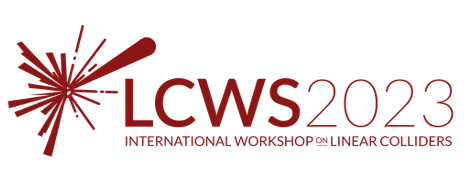Conveners
Physics and Detectors: Track 2
- Daniel Jeans (KEK IPNS)
- Patrizia Azzi (INFN/CERN)
- Thomas Madlener (DESY)
- Frank Gaede (DESY)
Physics and Detectors: Track 2
- Thomas Madlener (DESY)
- Lindsey Gray (Fermilab)
- Daniel Jeans (KEK IPNS)
- Frank Gaede (DESY)
- Patrizia Azzi (INFN/CERN)
Physics and Detectors: Track 2
- Thomas Madlener (DESY)
- Frank Gaede (DESY)
- Lindsey Gray (Fermilab)
- Daniel Jeans (KEK IPNS)
- Patrizia Azzi (INFN/CERN)
Two fermion production at the International Linear Collider (ILC) allows sensitive searches for new physics, such as heavy gauge bosons Z′. Combining the ILC's polarized beams with measurement of the tau lepton polarization allow detailed probes of the chirality of new interactions beyond the Standard Model.
The tau polarization can be extracted by measuring the distribution of tau decay...
In recent years, long-lived particles (LLPs) have been widely considered in a variety of Beyond the Standard Model (BSM) scenarios and in many different experimental searches for new particles. Future e$^+$e$^-$ colliders, thanks to their clean environment and triggerless operation, offer a unique opportunity to search for such states at sub-TeV energies. Considered in this contribution are...
Energy precision at the International Linear Collider (ILC) at 250 GeV is evaluated. To do so two difermion final states of $\mu^+\mu^-$ (dimuon), and $e^+e^-$ (Bhabha) are used. Beam dynamics are simulated using GuineaPig++ and event generation by KKMC for dimuons and BHWIDE for Bhabhas. A new Monte Carlo, GP2X, is written to convolve the beam dynamics with event generator output. The...
The particle physics community has concluded that the next collider should be an e+e− Higgs factory. Such a collider would also enable many other precision measurements, e.g. of the top quark and in the electroweak sector, as well as searches for exotic particles. In the ongoing discussions it has become increasingly clear that particle identification including charged hadron ID is a key...
The FCC-ee is a proposed future e$^+$e$^-$ collider capable of producing all SM particles in large quantities and clean experimental conditions. Up to four experiments can detect the collision products, with IDEA being one of the proposed detector concepts at FCC-ee. IDEA needs to fulfil requirements similar to experiments at other proposed lepton colliders such as reliable particle...
CLUE is a fast and innovative density-based clustering algorithm to group digitized energy deposits (hits) left by a particle traversing the active sensors of a high-granularity calorimeter in clusters with a well-defined seed hit. It was developed in the context of the new high granularity sampling calorimeter (HGCAL) which will be installed in the forward region of the Compact Muon Solenoid...
The Future Circular Collider (FCC) is designed to provide unprecedented luminosity and centre-of-mass energies via three options, namely FCC-ee, FCC-eh, and FCC-hh. At this stage, one of the priorities of the FCC program is the optimization of the detector concepts and physics reach. A critical component to maximize the physics reach is the identification of the flavor of the jet. To this end,...
There are emerging interest to improve performance of the event reconstruction using deep-learning techniques. We are working on algorithms based on Graph Neural Networks for both particle flow algorithm and quark flavor tagging. For the particle flow, we imported GravNet-based structure from CMS HGCal study and applied it for photon separation at ILC calorimeter. For the quark flavor tagging,...
Structured columnar data formats have seen significant adoption in LHC analyses, with more than half of modern CMS analyses using “NanoAOD” and its specialized variations. With this lightweight, 2kb/event, data format analysis groups are able to perform primary physics analysis, scale factor derivation, machine learning training and inference with and without expert features, and low level...
Electron-positron pair production and hadron photoproduction are the most important beam-induced backgrounds at linear electron positron colliders. Predicting them accurately governs the design and optimization of detectors at these machines, and ultimately their physics reach. With the proposal, adoption, and first specification of the C3 collider concept it is of primary importance to...
Machine-induced muon backgrounds at linear colliders are an important consideration when ensuring a high quality physics dataset, as this background can generate spurious missing-energy signals and degrade the ultimate physics reach in recoil-based measurements and searches. This rare background requires detailed beam-material interaction and transport simulations through many meters of...
I will summarize more and less recent studies of machine-related backgrounds in the context of the ILD concept.
Methods for measuring the absolute center-of-mass energy using dileptons from e+e- collision events
are further developed with an emphasis on detector and physics limitations.
We discuss three main types of estimator, the lepton momentum-based and angles-based center-of-mass
energy estimators discussed in arXiv:2209.03281, and a new estimator for
the electron and positron collision...
which interacts gravitationally with ordinary matter. If this dark sector contains a U(1) symmetry,
and a corresponding 'dark' photon ($A_{D}$) , it is natural to expect that this particle with kineticly mix
with the ordinary photon, and hence become a 'portal' through which the dark sector can be studied.
The strength of the mixing is given by a mixing parameter $(\epsilon)$. This
same...



